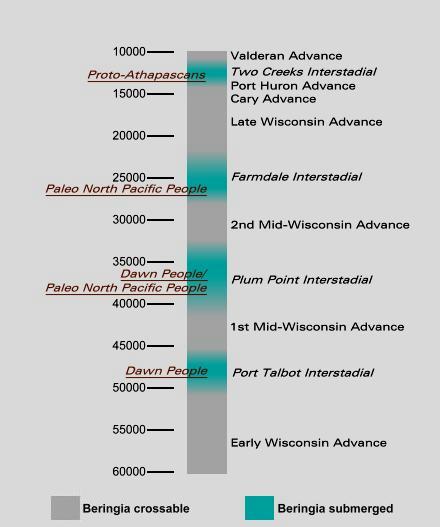
A Speculative Chronology of
the Occupation of the Americas
And one might ask why so much scholarly energy has been spent on the Beringia emigration hypothesis. Moving from place to place appears to be a signature human trait. Why are these particular movements of such interest?
The common assumption has pictured little bands of hunters unknowingly chasing their prey across Beringia into North America, thus establishing humankind in the Western Hemisphere.
Given that Beringia existed at various times (see the table below) for thousands of years, and that the sea is a highway rather than an impediment if one has a boat, there may have been large movements of populations back and forth between Asia and North America. If there are similarities between Siberians and Native Americans, they may be the result of emigration westward rather than eastward. (Horses began in North America and went westward while dying out in their original home.)
The following table is based on the hypothesis that ancient emigrants commonly crossed the gap between Alaska and Siberia by boat during relatively warm periods of high waterlines when they could use their maritime technology as opposed to, or in addition to, crossing during cold periods when low water exposed Beringia.
Perhaps expanding early human populations occupied rich coastline and estuary environments – where they developed methods of navigation – before they moved inland to become the wandering big-game hunters who supposedly were the first Americans.
We can be reasonably certain ocean-crossing technology was in use by sixty thousand years before the present because the ancestors of the Native Australians used it to reach Australia at about that time. So it is possible that the first wave of the human expansion was in position to expand across the northern arc of the Pacific by perhaps forty thousand years before the present, or even earlier.
The hypothetical Dawn People in the table were descendants of the leading edge of the original modern human migration eastward out of Africa, perhaps related to Native Australians.
The Paleo North Pacific people were perhaps related to the Ainus, with whom they may at times have formed bands of similar cultures along the islands and coastlines of the North Pacific arc from Japan to southern Alaska.
The Proto-Athapascans (the linguistic ancestors of modern Athapascan speakers) were perhaps more closely related to modern Siberians than earlier populations.

Possible migrations by sea during interstadial periods in North America in years before the present. Glacial advances and retreats adapted in part from Jesse D. Jennings, ed., Ancient North America (New York: W.H. Freeman, 1983), 28.